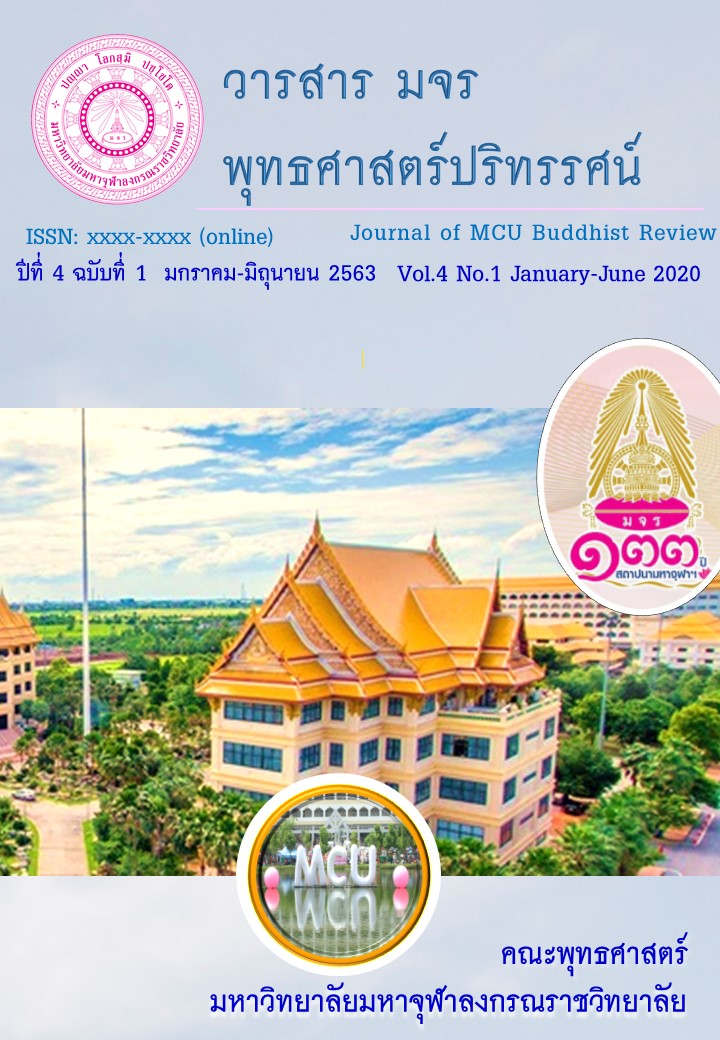ความสัมพันธ์ของขันธ์ ๕ ที่มีต่อการเจริญกรรมฐาน
Main Article Content
บทคัดย่อ
ความทุกข์เกิดขึ้นกับคนทุกคนเพราะมนุษย์มีร่างกายและจิตใจ คนจึงต้องดิ้นรนเพื่อให้พ้นทุกข์ คนเราเกิดขึ้นมาจากการประชุมรวมกันของขันธ์ ๕ ได้แก่ รูป เวทนา สัญญา สังขาร และวิญญาณ ขันธ์ คือ ร่างกายกับจิตใจ ขันธ์เป็นภาระที่ทำให้เกิดทุกข์ ในทางพระพุทธศาสนาสอนให้ดับทุกข์ด้วยการเจริญกรรมฐาน ซึ่งมีอยู่ ๔๐ วิธี ได้แก่ กสิณ ๑๐ อสุภะ ๑๐ อนุสติ ๑๐ พรหมวิหาร ๔ อาหาเรปฏิกูลสัญญา ๑ จตุธาตุววัฏฐาน ๑ และอรูป ๔ การเจริญกรรมฐานต้องใช้ร่างกายและจิตใจเป็นอุปกรณ์ในการพิจารณาและกำหนดรู้ เพราะคนทุกคนมีร่างกายและจิตใจ การเจริญสติจึงต้องใช้ขันธ์ ๕ เป็นอารมณ์ด้วยการกำหนดรู้ฐานทั้ง ๔ คือ กาย เวทนา จิต และธรรม พิจารณาจนเห็นความเกิดดับของขันธ์ ๕ เห็นตามธรรมชาติที่เกิดขึ้น เห็นตามความเป็นจริงว่ามีการเกิดขึ้นและดับไปนั้นไม่มีใครบังคับให้เกิดดับ เห็นไตรลักษณ์ ดังนั้น การเจริญกรรมฐานขาดเสียซึ่งขันธ์ ๕ ไปไม่ได้ ขันธ์ ๕ จึงมีความสัมพันธ์และส่งผลการเจริญกรรมฐานเป็นอย่างมาก
Article Details
- บทความที่ได้รับการตีพิมพ์เป็นลิขสิทธิ์ของวารสาร มจร พุทธศาสตร์ปริทรรศน์
- ข้อความใดๆ ที่ปรากฎในบทความที่ได้รับการตีพิมพ์ในวารสาร ถือเป็นความรับผิดชอบของผู้เขียนบทความ และข้อคิดเห็นนั้นไม่ถือว่าเป็นทัศนะและความรับผิดชอบของกองบรรณาธิการวารสาร มจร พุทธศาสตร์ปริทรรศน์
เอกสารอ้างอิง
พระธรรมธีรราชมหามุนี (โชดก ญาณสิทฺธิ). (2554). วิปัสสนากรรมฐาน. พิมพ์งานออกเมรุพระราชทานเพลิงศพ พระภัททันตะ อาสภมหาเถระ ธัมมาจริยะ อัคคมหากัมมัฏฐานาจริยะ.พิมพ์ครั้งที่ 3. กรุงเทพมหานคร: บริษัท ประยูรวงศ์พริ้นติ้ง จำกัด.
พระพรหมคุณาภรณ์ (ป.อ. ปยุตฺโต). (2551). พจนานุกรมพุทธศาสน์ ฉบับประมวลศัพท์, พิมพ์ครั้งที่ 11.กรุงเทพมหานคร: บริษัท เอส. อาร์. พริ้นติ้ง แมส โปรดักส์ จำกัด.
พระสัทธัมมโชติ ธัมมาจริยะ. (2540). ปรมัตโชติกะ ปริจเฉทที่ 1-2. กรุงเทพมหานคร: โรงพิมพ์ทิพยวิสุทธิ์.
มหาจุฬาลงกรณราชวิทยาลัย. (2539). พระไตรปิฎกภาษาไทย ฉบับมหาจุฬาลงกรณราชวิทยาลัย. กรุงเทพมหานคร: โรงพิมพ์มหาจุฬาลงกรณราชวิทยาลัย.
วศิน อินทสระ. (2557). สาระสำคัญแห่งวิสุทธิมรรค. พิมพ์ครั้งที่ 5. กรุงเทพมหานคร: โรงพิมพ์เม็ดทราย.
สุจิตรา อ่อนค้อม. (2556). การฝึกสมาธิ. พิมพ์ครั้งที่ 12. กรุงเทพมหานคร: หอรัตนชัยการพิมพ์.


